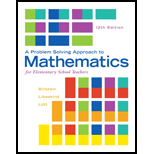
Assessment 14-2A
a. Refer to the following figure and suppose lines

b. Conjecture what single transformation will take
Want to see the full answer?
Check out a sample textbook solution
Chapter 13 Solutions
A Problem Solving Approach to Mathematics for Elementary School Teachers (12th Edition)
- the larger of two supplementary angles exceeds 7 times the smaller by 4°. Find the measure of the larger angle.arrow_forwardEvaluate the integral using any appropriate algebraic method or trigonometric identity. S- dy 18 √2 (1+y2/3) yarrow_forwardiid B1 Suppose X1, ..., Xn fx(x), where 2 fx(x) = x exp(−x²/0), 0<< (0 otherwise). (a) Find the maximum likelihood estimator of 0. (b) Show that the MLE is an unbiased estimator of 0. (c) Find the MSE of the MLE. Hint: For parts (b) and (c), you may use integration by parts.arrow_forward
- 4. Suppose the demand for a certain item is given by D(p)=-2 p² - 4p+350, where p represents the price of the item in dollars. a) Find the rate of change of demand with respect to price. b) Find and interpret the rate of change of demand when the price is $11.arrow_forward√3-x, x≤3, 2. For f(x) = 1 find each of the following. x > 3, x-3' 1. f(-6) 2. f(3) 3. f(7) 3. Find the domain of each of the following functions.arrow_forward1. Using the definition of the derivative, find f'(x). Then find f'(2), f'(0) and f'(3) when the derivative exists. a) f(x)=5x²-6x-1arrow_forward
- 2. f(x)=√7-x 4. A manufacturer has a monthly fixed cost of $40,000 and a production cost of $8 for each unit produced. The product sells for $12 per unit. 1. What is the cost function? 2. What is the revenue function? 3. Compute the profit corresponding to 12,000 units. 5. A rectangular box is to have a square base and a volume of 20 ft3. The material for the base costs $0.30 per ft2, the material for the sides cost $0.10 per ft2, and the material for the top costs $0.20 per ft2. Letting x denote the length of one side of the base,arrow_forwardSolve using superposition principlearrow_forwardreview problems please help!arrow_forward
- Solve the problems on the imagearrow_forward3. f(7) 3. Find the domain of each of the following functions. 1 1. f(x)=2-6x+8 2. f(x)=√√7-x 4. A manufacturer has a monthly fixed cost of $40,000 and a production cost of $8 for each unit produced. The product sells for $12 per unit.arrow_forward7. Evaluate the following limits and justify each step. (a) lim (3x²+2x+1) 1 x²+4x-12 (b) lim 1 2 x² - 2x t-√√3t+4 (c) lim t-0 4-t x²-6x+5 (d) lim (e) lim x 5 x-5 x→2 x²+2x+3 4u+1-3 (f) lim u➡2 u-2 1 (g) lim x-3 2 x 55 x - 7x4 +4 (h) lim xx 5x+2x-1 x+1 (i) lim x²-2x+5 - 7x8+4x7 +5xarrow_forward
 Elementary Geometry For College Students, 7eGeometryISBN:9781337614085Author:Alexander, Daniel C.; Koeberlein, Geralyn M.Publisher:Cengage,Algebra & Trigonometry with Analytic GeometryAlgebraISBN:9781133382119Author:SwokowskiPublisher:Cengage
Elementary Geometry For College Students, 7eGeometryISBN:9781337614085Author:Alexander, Daniel C.; Koeberlein, Geralyn M.Publisher:Cengage,Algebra & Trigonometry with Analytic GeometryAlgebraISBN:9781133382119Author:SwokowskiPublisher:Cengage

